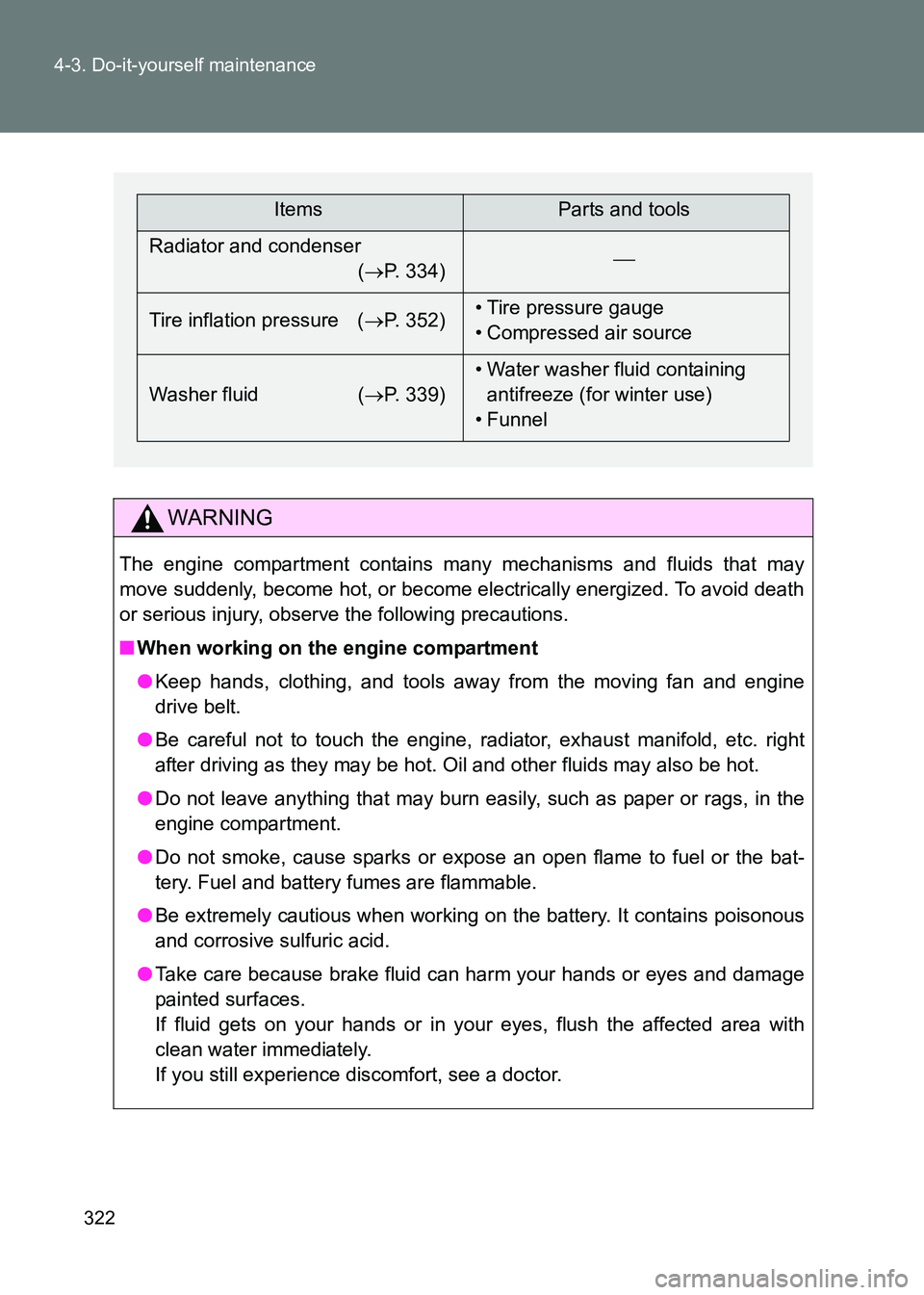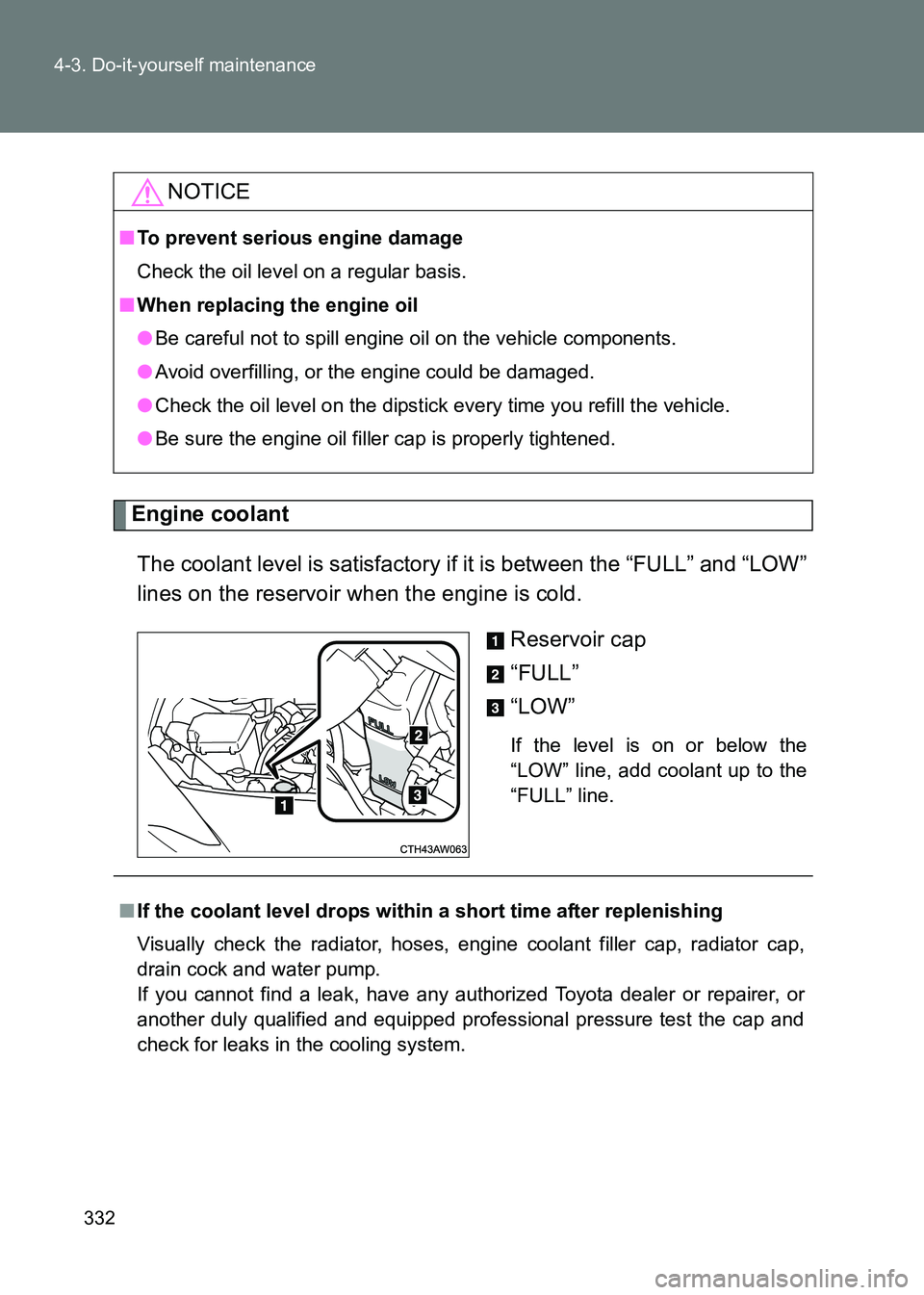Page 322 of 505

322
4-3. Do-it-yourself maintenance
86_EE (OM18071E)
WARNING
The engine compartment contains many mechanisms and fluids that may
move suddenly, become hot, or become electrically energized. To avoid death
or serious injury, observe the following precautions.
■
When working on the engine compartment
●Keep hands, clothing, and tools away from the moving fan and engine
drive belt.
● Be careful not to touch the engine, radiator, exhaust manifold, etc. right
after driving as they may be hot. Oil and other fluids may also be hot.
● Do not leave anything that may burn easily, such as paper or rags, in the
engine compartment.
● Do not smoke, cause sparks or expose an open flame to fuel or the bat-
tery. Fuel and battery fumes are flammable.
● Be extremely cautious when working on the battery. It contains poisonous
and corrosive sulfuric acid.
● Take care because brake fluid can harm your hands or eyes and damage
painted surfaces.
If fluid gets on your hands or in your eyes, flush the affected area with
clean water immediately.
If you still experience discomfort, see a doctor.
ItemsParts and tools
Radiator and condenser (→ P. 334)
Tire inflation pressure ( →P. 352) • Tire pressure gauge
• Compressed air source
Washer fluid ( →P. 339) • Water washer fluid containing
antifreeze (for winter use)
• Funnel
Page 323 of 505

323
4-3. Do-it-yourself maintenance
4
Maintenance and care
86_EE (OM18071E)
WARNING
■
When working near the electric cooling fans or radiator grille
Vehicles without a smart entry & start system: Be sure the engine switch is
off. With the engine switch in the “ON” position, the electric cooling fans may
automatically start to run if the air conditioning is on and/or the coolant tem-
perature is high. ( →P. 334)
Vehicles with a smart entry & start system: Be sure the “ENGINE START
STOP” switch is off. With the “ENG INE START STOP” switch in IGNITION
ON mode, the electric cooling fans may automatically start to run if the air
conditioning is on and/or the cool ant temperature is high. (→P. 334)
■ Safety glasses
Wear safety glasses to prevent flying or falling material, fluid spray, etc. from
getting in the eyes.
NOTICE
■ If you remove the air cleaner filter
Driving with the air cleaner filter removed may cause excessive engine wear
due to dirt in the air.
■ If the fluid level is low or high
It is normal for the brake fluid level to go down slightly as the brake pads
wear or when the fluid level in the accumulator is high.
If the reservoir needs frequent refilling, it may indicate a serious problem.
Page 328 of 505
328
4-3. Do-it-yourself maintenance
86_EE (OM18071E)
Engine compar tment
*: For right-hand drive vehicles: This is located on the opposite side of theengine compartment.
Battery* ( →P. 335)
Engine oil level dipstick (→ P. 329)
Engine oil filler cap (→ P. 330)
Washer fluid tank ( →P. 339)Electric cooling fans
Condenser (if equipped)
(→ P. 334)
Radiator ( →P. 334)
Engine coolant reservoir (→ P. 332)
Fuse box ( →P. 364)
Page 332 of 505

332
4-3. Do-it-yourself maintenance
86_EE (OM18071E)
Engine coolant
The coolant level is satisfactory if it is between the “FULL” and “LOW”
lines on the reservoir when the engine is cold. Reservoir cap
“FULL”
“LOW”
If the level is on or below the
“LOW” line, add coolant up to the
“FULL” line.
NOTICE
■To prevent serious engine damage
Check the oil level on a regular basis.
■ When replacing the engine oil
●Be careful not to spill engine oil on the vehicle components.
● Avoid overfilling, or the engine could be damaged.
● Check the oil level on the dipstick every time you refill the vehicle.
● Be sure the engine oil filler cap is properly tightened.
■If the coolant level drops within a short time after replenishing
Visually check the radiator, hoses, engi ne coolant filler cap, radiator cap,
drain cock and water pump.
If you cannot find a leak, have any authorized Toyota dealer or repairer, or
another duly qualified and equipped professional pressure test the cap and
check for leaks in the cooling system.
Page 333 of 505

333
4-3. Do-it-yourself maintenance
4
Maintenance and care
86_EE (OM18071E)
■
Coolant selection
Only use “TOYOTA Genuine 50/50 Pre-mixed Super Long Life Coolant
BLUE” or similar high-quality ethylene glycol-based non-silicate, non-amine,
non-nitrite, and non-borate coolant with l ong-life hybrid organic acid technol-
ogy.
“TOYOTA Genuine 50/50 Pre-mixed Super Long Life Coolant BLUE” is a
mixture of 50% coolant and 50% deionized water. (Enabled: -35 °C [-31 °F])
For more details about engine coolant, contact any authorized Toyota dealer
or repairer, or another duly qualified and equipped professional.
WARNING
■ When the engine is hot
Do not remove the radiator cap.
The cooling system may be under pressure and may spray hot coolant if the
cap is removed, causing serious injuries, such as burns.
NOTICE
■When adding engine coolant
Coolant is neither plain water nor stra ight antifreeze. The correct mixture of
water and antifreeze must be used to provide proper lubrication, corrosion
protection and cooling. Be sure to read the antifreeze or coolant label.
■ If you spill coolant
Be sure to wash it off with water to prevent it from damaging parts or paint.
Page 334 of 505
334
4-3. Do-it-yourself maintenance
86_EE (OM18071E)
Radiator and condenser
Check the radiator and condenser and clear away any foreign
objects.
If either of the above parts are extremely dirty or you are not sure of
their condition, have your vehicle checked by any authorized Toyota
dealer or repairer, or another duly qualified and equipped profes-
sional.
WARNING
■ When the engine is hot
Do not touch the radiator or condenser as they may be hot and cause seri-
ous injuries, such as burns.
Page 464 of 505

464
5-2. Steps to take in an emergency
86_EE (OM18071E)
If your vehicle overheats
Correction proceduresStop the vehicle in a safe place and turn off the air condition-
ing system, and then stop the engine.
If you see steam: Carefully lift the hood after the steam subsides.
If you do not see steam: Carefully lift the hood.
After the engine has cooled
down sufficiently, inspect the
hoses and radiator core (radia-
tor) for any leaks.
Radiator
Cooling fans
If a large amount of coolant leaks,
immediately contact any autho-
rized Toyota dealer or repairer, or
another duly qualified and
equipped professional.
The following may indicate that your vehicle is overheating.
●Vehicles with a monochrome multi-information display: The
engine coolant temperature gauge ( →P. 200) enters the red
zone or a loss of engine power is experienced (for example, the
vehicle speed does not increase).
Vehicles with a color multi-information display: The high engine
coolant temperature warning light ( →P. 204) flashes or illumi-
nates or a loss of engine power is experienced (for example, the
vehicle speed does not increase).
● Steam comes out from under the hood.
STEP 1
STEP 2
STEP 3
Page 465 of 505

5
465
5-2. Steps to take in an emergency
When trouble arises
86_EE (OM18071E)
The coolant level is satisfactory if
it is between the “FULL” and
“LOW” lines on the reservoir.
Reservoir
“FULL”
“LOW”
Radiator cap
Add coolant if necessary.
Water can be used in an emer-
gency if coolant is unavailable.
Start the engine and turn the air conditioning system on to
check that the radiator cooling fans operate and to check for
coolant leaks from the radiator or hoses.
The fans operate when the air conditioning system is turned on
immediately after a cold start. Confirm that the fans are operating by
checking the fan sound and air flow. If it is difficult to check these,
turn the air conditioning system on and off repeatedly.
(The fans may not operate in freezing temperatures.)
If the fans are not operating: Stop the engine immediately and contact any authorized
Toyota dealer or repairer, or another duly qualified and
equipped professional.
If the fans are operating: Have the vehicle inspected at the nearest authorized
Toyota dealer or repairer, or another duly qualified and
equipped professional.
STEP 4
STEP 5
STEP 6
STEP 7